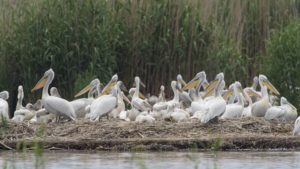The historical and current distribution of Dalmatian Pelican Pelecanus crispus and Great White Pelican Pelecanus onocrotalus in Greece and adjacent areas: 1830-2019
George Handrinos and Giorgos Catsadorakis
Abstract:
Evidence about the historical breeding distribution of Dalmatian Pelicans Pelecanus crispus and Great White Pelicans Pelecanus onocrotalus in Greece and an adjacent zone was sought in all historical scientific literature containing references to pelicans, starting from the antiquity. Pelicans were familiar to ancient Greeks, although the two species were not distinguished. Aristotle was the first to observe and describe their migration movements in the Balkans. Subsequently, nothing was mentioned for pelicans until the 16th century observations and writings of Pierre Belon du Mans. In mid-19th century the first scientific data for both species appeared and nesting of the Dalmatian Pelicans was noted for the period 1830- 1900 in seven wetlands at Peloponnese and south mainland Greece and six at northern Greece and adjacent areas along latitude 41oN. It is impossible to evaluate the actual status of pelicans in the region during 1900-1950 as none of the few contemporary ornithological publications mentioned anything about nesting of pelicans in Greece. The breeding range of Dalmatian Pelicans had probably shrunk dramatically, although it is unlikely that all the old colonies were exterminated. Until the end of 1970s, many of the wetlands where Dalmatian pelicans bred were drained or heavily altered and the number of known colonies was reduced from seven to three, with two of them in Greece, at Amvrakikos and Lake Mikri Prespa and one at Karavasta in Albania. Scientific and conservation work initiated in 1983 mainly by the “International Pelican Research and Conservation Project” and conservation organisations, led at the turn of the century to a manyfold increase of the Amvrakikos and the Lake Mikri Prespa Dalmatian pelican colonies, which subsequently gave rise to four new colonies in the period 2003-2015: Lake Kerkini, Messolonghi lagoons, Karla Reservoir and Lake Chimaditis. The overall breeding population rose from 100-120 pairs and two colonies in the late ‘60s to over 2100 pairs and six colonies in the end of the 2010s. Simultaneously, the Great White Pelican breeding population rose from less than 100 pairs and one colony to over 700 pairs and three colonies.
